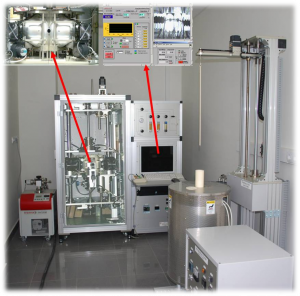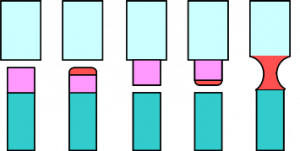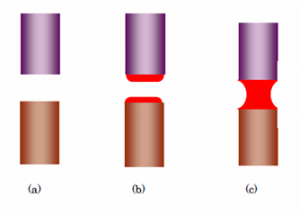Laboratory Thin Film and Crystal Growth Laboratory consists of several crystal growth techniques such as Czochralski, Bridgman or floating zone, thin film technology methods (thermal evaporation, spattering, laser ablation), sol-gel technology, spin-coating technique, sintering, etc. Here we will show only two crystal growth techniques.
Crystal growth using floating zone technique: Four Mirror Lamp Image Furnace.
The floating zone technique is a powerful tool for the fabrication of high quality single crystals as well as for the purification of materials. A new four mirror optical floating zone furnace FZ-T-1000-H-HR-I-VPO-PC (Crystal System Co.) consists of four ellipsoidal mirrors made of Pyrex glass coated with highly reflective aluminum. The mirrors are air-cooled in order to prevent moisture condensation on the ellipsoidal surfaces. The principle of this technique is that radiation from the Halogen lamps is reflected and focused by the mirrors onto the bar sample to form a molten zone at the tip of the feed rod. Then the molten (floating) zone is translated along the sample length by moving the mirror stage with respect to the sample. The crystal is grown on the solidifying end of the floating zone. In addition, a rotation movement of the rod improves the microstructural homogeneity during directional solidification.
In the crucibleless floating zone technique the molten zone is kept together by capillary forces. The optical heating is the optimal way to bring a narrow zone of the sample to melting. In FZ-T-1000-H-HR-I-VPO-PC optical furnace the maximum operating temperature is 2200°C in atmosphere (air, nitrogen, oxygen, argon, etc) within the pressure range from 5×10-5 up to 10 bars. Crystals can be obtained up to 150 mm in length and 10 mm in diameter, with a growing rate of 0.05-27 mm/h and a 5-60 rpm rotating rate.

Four mirror optical furnace model FZ-T-1000-H-HR-I-VPO-PC (Crystal System Co.) with vertical molysili furnace model VF1800 (right).
Advantages of the four mirror floating zone furnace:
- Stable molten zone – Using high quality four glass mirrors and aluminum frame, a stable molten zone can be achieved;
- Small size – Mirror stage moving system can diminish the scale of the furnace, so that crystals as long as150 mm can be grown;
- Remote monitor and remote control system – Connect a PC to LAN system, monitoring and controlling of the furnace can be done from anywhere in the world;
- PC control – All the parameters for growing single crystals can be set and controlled by the personal computer;
- High quality glass mirror – Suitable for a long-term use, and optimal conditions are easily maintained. The surface is easy to clean, no damage occurs;
- Variety of halogen lamps – The most suitable lamp can be selected from various power lamps (150W, 300W, 500W, 1,000W and 1,500W lamp are available);
- Monitoring by the CCD camera – High quality color CCD camera and monitor can give real time control of the growth;
Phase research by the slow cooling float zone method – Stable molten zone by the four mirror system can give the phase relation using the slow cooling float zone method.
|
The growth of incongruently melting or peritectic compounds
|
Growth of congruently melting compounds
|
|
| 1) First stage: Set the solvent zone chip on the top of the seed rod. A small amount of starch paste can be used to fix it. The starch will be burnt off as the temperature increases, and a small amount of smoke will appear.
2) Second stage: Both the top of the solvent zone chip and the end of the feed rod are partially melted, and connected without rotation of either the upper or lower shafts. After connecting, the lamp power is slightly decreased and the upper shaft is retracted to separate the solvent zone. 3) Third stage: Both the end of the solvent zone chip and the top of the seed rod are partially melted, and brought into contact with rotation of both shafts. 4) Final stage: Adjust the lamp power to keep the molten zone stable and to melt a few millimeters of the top portion of the seed. After a few minutes, the crystal growth will begin. |
1) At the initial stage of the heating, both the feed and seed rod are set apart by a distance of a few mm;
2) As the heating progresses, both ends of the feed and seed rod will begin to melt; 3) At this stage, the upper feed rod is moved to downwards until it touches the seed rod. Finally, the length of the molten zone is adjusted so that its diameter is almost the same as that of the feed and seed rod. |
|
Advantages of Floating zone in comparison with the Czochralski method:
- High purity crystals can be grown without contamination from the crucible;
- Can be applied to grow oxide, metal and other materials;
- Can grow single crystals of incongruently melting materials;
- Low cost of the crystals growth;
- Can be applied in phase research by the slow cooling float zone method.

